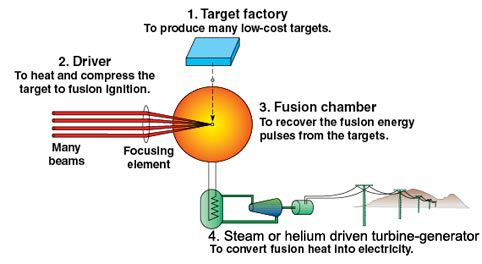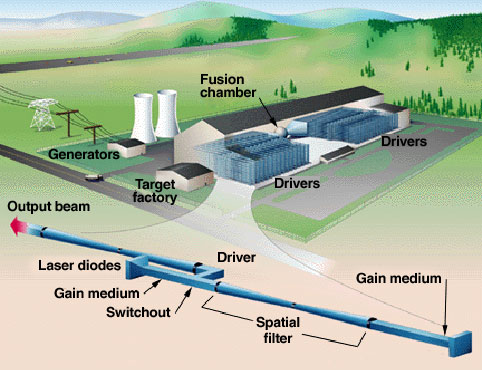How IFE Works
In an IFE power plant, many (typically 5-10) pulses of fusion energy per second would heat a low-activation coolant, such as lithium-bearing liquid metals or molten salts, surrounding the fusion targets. The coolant in turn would transfer the fusion heat to a power conversion system (e.g., steam-based Rankine cycle or high pressure helium-based Brayton cycle) to produce electricity.

Only a few NIF experiments can be conducted in a single day because the facility's optical components need time to cool down between shots. In an IFE power plant, targets will be ignited five to ten times a second. The requirement to operate at high pulse repetition rates (rep-rate for short) poses significant R&D challenges:
Target Performance
Experiments on NIF will demonstrate energy gain the ratio of fusion energy from the ICF target divided by laser energy input greater than ten. Advanced targets that can be tested on NIF after the initial ignition campaign begins in 2010 may achieve gains of 50 or more. For IFE, a target gain greater than about 100 is needed in order to minimize the portion of generated electric power that has to be recirculated within the plant to operate the laser.
https://lasers.llnl.gov/science_technology/fusion_science/fast_ignition.php">Fast ignition targets are expected to give gains of several hundred. A high recirculating power fraction means there is less power available for sale, so the cost of electricity will be higher.
Target Factory
The target factory must produce a continuous supply of high-quality targets at an acceptable cost typically 25¢ for a target that produces 300 megajoules of energy. Many types of targets are being considered for laser IFE, including indirect-drive (like those that will be shot on NIF), direct-drive (currently being tested on the OMEGA laser at the University of Rochester), and advanced designs including fast ignition and shock ignition (see
https://lasers.llnl.gov/programs/nic/target_fabrication.php">Target Fabrication). In all cases, the deuterium-tritium (D-T) fusion fuel is contained in a spherical fuel capsule. Near-term experiments planned for NIF will use capsules made of beryllium, carbon or carbon-hydrogen polymers, but for IFE plants, it is likely that polymer capsules will be the preferred material. The fuel capsule must be cold enough for D-T to freeze and form a layer of D-T ice on the inner wall of the capsule.
In direct-drive, the capsule is directly irradiated by the laser beams. In indirect-drive, the capsule is placed inside a hohlraum, a tiny, can-shaped container made with high-atomic-mass materials like gold and lead with holes on the ends for beam entry. If the power plant operates at five shots a second, the target factory will have to produce more than 400,000 targets a day. Detailed conceptual design studies for IFE target factories have been completed by
http://www.ga.com/">General Atomics, a participant in the National Ignition Campaign.
Target Injection and Tracking
In NIF, targets are held in place at the center of the chamber and the beams are aligned to the ideal fixed position for each shot. For IFE, targets will have to be injected at speeds greater than 100 meters a second and tracked in flight to provide data to a real-time beam-pointing system needed to assure the precise illumination required to achieve ignition and high energy gain. Target injection experiments using gas guns have been conducted at General Atomics with room-temperature surrogates. Conceptual designs for other types of injectors, such as electromagnetic accelerators, and for target tracking and beam pointing systems have also been completed. While researchers are satisfied with progress to date, significant development remains to demonstrate that the requirements for IFE can be met.
High Rep-Rate Laser
A key component of a laser IFE power plant is of course the laser. While the total energy of the laser is likely to be comparable to or even less than that of NIF, the IFE laser must operate at five to ten shots a second depending on the target yield per shot and the desired electric output of the power plant. Currently two classes of laser are being considered in the United States: the krypton-fluoride (KrF) gas laser and the diode-pumped solid state laser (DPSSL). At LLNL, research is focused on the DPSSL, building on more than 35 years of experience with solid-state lasers leading up to NIF. In addition to the ability to operate at high rep-rates, key considerations for the IFE laser include high efficiency (preferably greater than 10 percent), low cost (to keep the cost of electricity competitive with other energy options), long-life optics, high reliability and low maintenance costs. The
https://lasers.llnl.gov/programs/psa/fusion_energy/mercury.php">Mercury laser project has been LLNL's first step in developing a laser to meet those requirements. Lessons learned from Mercury, combined with new ideas on laser architecture and continuing improvements in components such as diode arrays and materials science, are setting the stage for the next step in DPSSL development: the design and construction of a single beamline that, if replicated 25 to 100 times, would provide the energy needed for IFE.
Fusion Chamber
Each fusion target releases a burst of fusion energy in the form of high-energy (14-million-electron-volt) neutrons (about 70 percent of the energy), X-rays and energetic ions.

An artist's rendition of a laser fusion power plant driven by diode-pumped solid-state lasers. Experiments at the National Ignition Facility will help clarify whether it is economically feasible to generate electricity by laser fusion.
The fusion chamber must contain this blast of energy and convert the sequences of energy pulses into a steady flow of power for the power conversion system. The chamber design must include a 50- to 100-centimeter-thick region that contains lithium (as a liquid metal, molten salt or solid compound) in order to produce tritium through nuclear reactions with the fusion neutrons. This region is called the breeding blanket and must produce at least one tritium atom for every tritium atom burned in the fusion target a tritium breeding ratio equal to or greater than one. A key issue for the chamber is the survival of the innermost wall (first wall) that is exposed to intense heat and radiation from the target's X-rays, ions and neutrons. Various chamber designs have been proposed and fall into three major classes:
- Dry-wall, where the innermost surface is a solid material such as tungsten designed to handle the full target energy impact
- Wetted-wall, where a thin liquid layer coats the first wall and absorbs the short-range X-rays and ions before they can damage the wall
- Thick liquid wall, where more than 50 centimeters of liquid (lithium-bearing metal or molten salt) flows between the target and first wall and provides protection from X-rays, ions and neutrons.
Another key issue for the fusion chamber is intra-shot recovery: the conditions inside the chamber (such as vapor and droplet density) that must be recovered between each shot to the point that the next target can be injected and the laser beams can propagate through the chamber to the target. Finally, the chamber must operate at high temperature more than 500 degrees Celsius in order to achieve high efficiency in the power conversion system.
Power Conversion System
By flowing a coolant through the fusion chamber at a steady rate, the pulsed fusion energy can be extracted at a constant rate and delivered to the power conversion system, which converts the thermal power to electric power. When liquids such as lithium, lead-lithium alloys or the molten fluorine-lithium-beryllium molten salt "flibe" are used for tritium breeding, the liquid is generally circulated as the primary coolant for the fusion chamber. When solid breeders such as lithium-aluminate (LiAl02) are used, high-pressure helium serves as the chamber coolant. In either case, the primary coolant circulates through heat exchangers that power electric power equipment. The efficiency of the power conversion systems depends on the outlet temperature of the primary coolant, which is limited by the materials used in the construction of the chamber. With advanced material being developed for fusion and other applications, conversion efficiencies of 40 to 50 percent will be possible. Some work has also been done on ideas for converting a portion of the target energy output directly to electricity.
Separability and Integration
An advantage of IFE compared to magnetic fusion is that, at least in the early stages, the subsystems described above can be developed and tested separately and often at lower cost than fully integrated facilities. The IFE power plant, however, requires successful integration of all the components with careful attention to the interfaces and the impact of design choices for one system on the others. Using liquids in the chamber to protect the first wall, for example, introduces the issue of keeping liquid off the final optics.
Safety and Environment
As researchers develop concepts for IFE power plants, they are mindful of the need to develop safe and environmentally acceptable sources of energy. Use of low-activation materials and design options such as the thick liquid wall chamber can minimize the production of activated material over the life of the plant. Control of tritium will be important for any type of fusion power plant, since its release dominates consequences in analyses of hypothetical accident scenarios.
It must be very depressing for them to be shown to be so ill-informed.